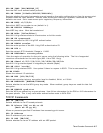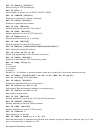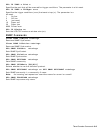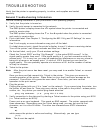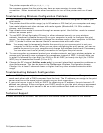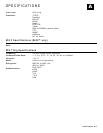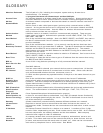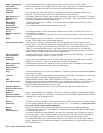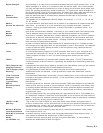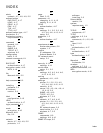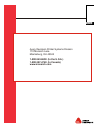LEAP (Lightweight
Extensible
Authentication
Protocol)
Cisco Systems® introduced this authentication protocol and provides mutual
authentication with unique WEP keys for each user. New keys are issued based on a
time limit. Changing the WEP key time limits provides additional security.
LPD/LPR A printer protocol that uses TCP/IP to establish connections between printers on a
network. Also known as Line Printer Daemon/Line Printer Remote.
MAC Address or
Media Access
Control
A hardware address (6-byte) that uniquely identifies each node of a network. The MAC
address is set during manufacturing and does not change. Also, two Network Interface
Cards (NIC) will not have the same value.
MSCHAPv2
(Challenge
Handshake
Authentication
Protocol)
The Microsoft® version of CHAP. It is a three-way handshake protocol that is more
secure than PAP.
It provides mutual authentication between devices.
NIC or
Network Interface
Card
An adapter (board or card) that can be inserted into a device, so the device can be
connected to a network.
The NIC converts data from the device into the form transmitted or received from the
network
Node A processing location on a network. The location can be a workstation, computer, or
printer. Each Node has a unique MAC address.
Open Authentication This allows any device to authenticate and then attempt to communicate with the
access point. Any wireless device can authenticate with the access point, but if WEP is
used, the device can communicate only if its WEP keys match the access point's.
There is no challenge that occurs, you either have the correct key or not when you
communicate with the access point. By eliminating the challenge process, it actually
makes this more secure than shared key authentication.
PAP (Password
Authentication
Protocol)
A simple authentication protocol used with PPP (Point-to-Point Protocol). It is a plain
text password system, which is not very secure.
Pathname The location of a particular file or directory that includes the full path to the needed
filename or directory. This is a combination of path and filename.
PEAP (Protected
Extensible
Authentication
Protocol)
Authenticates clients into a network using only server-side certificates, which makes
implementing and administering a wireless LAN easier.
Ping A way to determine if a device is accessible. It sends a packet to the specified address
and waits for a reply.
Protocol This is the way two devices transmit data between each other, including error checking,
data compression, and how messages start and end.
PSK
(Pre-Shared Key)
Authentication mode of WPA used in SOHO environments. The key value (or pass-
phrase) is used for network authentication only (not data encryption). It does not use a
RADIUS server like the other modes, but uses a shared key to provide the initial
authentication with the access point or host.
RADIUS (Remote
Authentication Dial-
In Server)
This is an authentication server, such as the Cisco® ACS, Microsoft® IAS, etc.
RARP or
Reverse Address
Resolution Protocol
One of the available boot methods. The device sends an RARP request and the RARP
server responds with an IP address. The device knows its MAC address and the server
responds with the IP address for it.
Relative
Pathname
The file or directory location on the user’s system relative to the user’s current location
on the system (what directory the user is currently in). For example, c:\\program files\
monarch software\mpcl toolbox\9460.phu
Router Any device that forwards data along networks. Routers are located at gateways.
Shared
Authentication
The access point sends an unencrypted challenge text string to any device attempting
to communicate with it.
The device requesting authentication encrypts the challenge text and sends it back to
the access point. If the challenge text is encrypted correctly, the access point allows
the requesting device to authenticate. Both the unencrypted challenge and the
encrypted challenge can be monitored; however, this leaves the access point open to
attack. Because of this weakness, shared key authentication can be less secure than
open authentication.
G-2 System Administrator’s Guide



